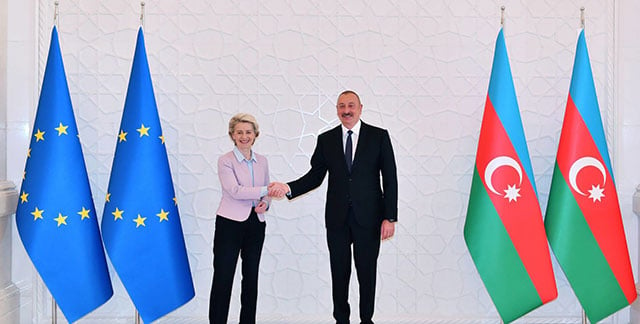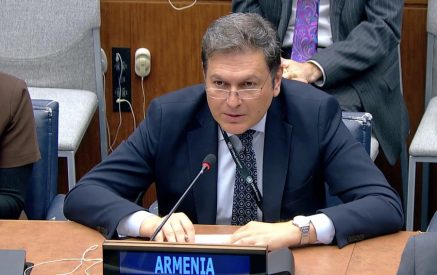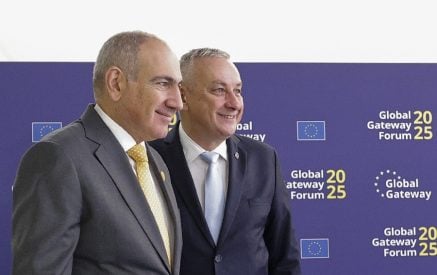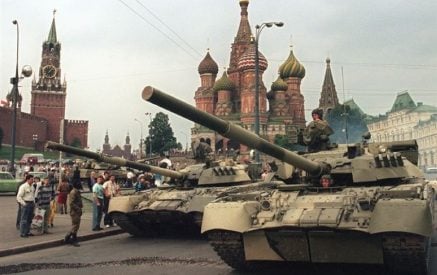by The Armenian Weekly
Yeghia Tashjian
The “Great Game” was a political and diplomatic confrontation that existed for most of the 19th century and the beginning of the 20th century between the British Empire and the Russian Empire over Afghanistan and Central Asia, aiming to control trade routes in India. Almost a century later, with the dissolution of the Soviet Union, the “Game” returned, and a fierce competition arose between the Russians and the Americans and their Western allies to control the oil and gas fields and pipelines in the South Caucasus.
In 1998, the Washington Post (WaPo) published a series of articles about the importance of oil and gas security in the Caspian Sea. In the third article titled “A British ‘Coup’,” WaPo reported that in September 1992, the former British PM Margaret Thatcher arrived in Baku and handed the Azerbaijani government two BP (British Petroleum) checks totaling 30 million USD. To the Azerbaijani government, which was waging a war against Armenia over Nagorno-Karabakh, a deal with BP was tantamount to a deal with the British government.
Read also
At first, the Americans were not interested in Azerbaijani oil due to pressure from American-Armenian lobbying groups. But after Heydar Aliyev took office in June 1993, US interest grew as Washington viewed the 70-year-old former KGB chief coming to power as a Moscow-engineered coup aiming to block major oil deals between Baku and the West. Ultimately, Aliyev turned out to be the leader who invited US oil companies to Azerbaijan.
On September 20, 1994, Aliyev and oil executives gathered in Baku for the ceremonial signing of what the Azerbaijani president called the “deal of the century.” A contract was signed between the State Oil Company of Azerbaijan Republic (SOCAR) and a consortium of 11 foreign oil companies from six nations for the development of an area that covered three major oil fields in the Azerbaijan sector of the Caspian Sea – Azeri, Chirag and Deepwater portion of the Gunashli field (ACG). As a result, American companies – Amoco, McDermott, Unocal and Pennzoil – collectively took a more than 40-percent share in investing in the Azerbaijani oil field, followed by BP with 17 percent.
Russia had signaled resistance against these projects. Back then, the Caspian landlocked resources could reach Europe either through Russia or Iran. To find an alternative route, during the summer of 1995 the Americans convinced the BP executive to finance 250 million USD in constructing a pipeline connecting Baku to Georgia’s Black Sea port of Supsa. It was during US President Bill Clinton’s era that the Americans supported the policy of “multiple pipelines.” However, this decision still had to be sold to Aliyev. US National Security advisor Anthony Lake privately asked Zbigniew Brzezinski, his predecessor in the Carter administration, to carry a letter from President Clinton to his Azerbaijani counterpart. The letter also mentioned US willingness to resolve the Nagorno-Karabakh conflict with Armenia.
Brzezinski was also serving as Amoco’s paid consultant in Baku and scheduled a private meeting with Aliyev to summarize the contents of the letter. The Russians, knowing of a “conspiracy” underway against their interests, were pressuring Aliyev to export all of Azerbaijan’s oil through Russia; Russian troops stationed in Azerbaijan were to remain there. On October 2, after a call from Clinton assuring a US-Azerbaijani tacit alliance, Aliyev approved the American plan. By early 1996, the Russians knew they were out of the deal. This was the beginning of American-Russian energy friction in the South Caucasus.
The American-British project led to the construction of the Baku-Tbilisi-Ceyhan (BTC) oil export pipeline. The BTC spans three countries and 1,768 kilometers from Azerbaijan through Georgia to the Mediterranean where a new marine terminal has been constructed at Ceyhan, Turkey. BTC’s throughput capacity has been increased from its design capacity of one million barrels per day to its current capacity of 1.2 million barrels per day. To date, the pipeline has carried a total of 3.6 billion barrels (about 482 million tonnes) of crude oil from the Caspian to the Mediterranean bypassing Russia and decreasing Europe’s energy dependence on Moscow.
Remember the “Nabucco” Pipeline Politics?
The “Nabucco” pipeline was a project of strategic importance. It aimed to connect Europe with the natural gas sources in the Caspian Sea and the Middle East regions. The project has been driven by the intention to diversify Europe’s current energy supplies and lessen the continent’s dependence on Russian energy, which is the biggest supplier of gas to Europe.
In June 2008, Baku signed the first contract to supply gas to Bulgaria. Later, the Turkish Minister of Energy confirmed that Turkey was ready to join the deal, provided that Turkey gets 15-percent of the natural gas to be carried through the new pipeline. In January 2009, the Nabucco Summit was held in Budapest followed by an intergovernmental agreement signed by the PMs of Turkey, Romania, Bulgaria, Hungary and Austria. The idea was to establish a 2,730-kilometer pipeline connecting Eastern Europe to Georgia through the South Caucasus Pipeline, two more routes connecting Turkey to Iraq and the Ankara-Tabriz pipeline of Iran.
The potential suppliers for the original Nabucco project were considered to be Iraq, Azerbaijan, Turkmenistan and Egypt. However, many experts criticized the project as uneconomic because there was no guarantee that there would be sufficient gas supplies to make it profitable. The Europeans were planning for pipeline construction even before securing the gas supplies. Meanwhile, it was during this period that Armenia and Turkey signed the Zurich Protocols; both the US and the European Union were pushing for border opening between the countries. There were even some ideas being circulated that Armenia was getting transit from the Nabucco pipeline. This factor antagonized Azerbaijan, which accused Turkey of betraying its “small brother” and used the energy card against Ankara and the West.
Russia, taking advantage of Baku’s resentment, made gas deals with Azerbaijan and Turkmenistan, which has been seen by some observers as an attempt to reserve potential Nabucco supplies. Azerbaijan gave priority to Gazprom to sell the second phase of the Shah Deniz deposit, which Europe was counting on to fill the Nabucco pipeline, to Russia.
Meanwhile, Russia was working on its own pipeline project. Moscow was able to safeguard its dominant market share in Central and Eastern Europe and then pressured most of these countries to support Gazprom’s South Stream pipeline, a rival to Nabucco. According to Judy Dempsey, an Irish journalist and international relations researcher, Russia, to try and prevent Nabucco from even being built, decided to construct the alternative South Stream pipeline. That would allow Gazprom to send its gas to Southern and Central Europe via a pipeline under the Black Sea. South Stream was all about undermining Nabucco’s ambitions and Moscow’s efforts to find suppliers to fill its own pipeline. Olgu Okumus, an affiliated lecturer in energy diplomacy at Sciences Po, said that by blowing off the Nabucco gas pipeline project, Europe was left more vulnerable to Russia’s energy monopoly than ever.
Who is winning the “Great Game”?
The war in Ukraine has increased Europe’s vulnerability against Russia when it comes to energy security. As Russia supplies 40-percent of Europe’s natural gas amid the western-backed sanctions, President Putin announced that “unfriendly” countries would have to pay for such deliveries in rubles. On April 26, the Russian state-owned energy company Gazprom announced that it had suspended gas deliveries to Poland and Bulgaria and would not restart them until payments were made in the Russian currency. This step triggered outrage in the EU, and officials accused Moscow of “blackmail” as Russia started using its energy card as a weapon, thus pushing the Europeans to search for alternative energy supplies.
On July 18, 2022, the European Commission signed a Memorandum of Understanding with Azerbaijan to double imports of Azerbaijani natural gas to at least 20 billion cubic meters (bcm) a year by 2027. “The EU and Azerbaijan are opening a new chapter in energy cooperation. Azerbaijan is a key partner in the EU’s efforts to move away from Russian fossil fuels,” said European Commission president Ursula von der Leyen.
Azerbaijani President Ilham Aliyev stressed that “issues of energy security today are more important than ever before.” Azerbaijan started increasing natural gas deliveries to the EU from 8.1 bcm in 2021 to around 12 bcm in 2022 via the Southern Gas Corridor. It is worth mentioning that the Trans-Adriatic pipeline, the final link of the Southern Gas Corridor pipeline network linking the Caspian gas to Europe via Turkey, has brought more than eight bcm of Azerbaijani gas to Europe in 2021. The gas from Azerbaijan arrives in Europe via Turkey through the Trans Anatolian Pipeline, which is connected to the bloc’s Trans Adriatic Pipeline, supplying gas from Greece to Italy.
Already Moscow was aware of the agreement and on the same day, Gazprom told its European customers that it cannot guarantee gas supplied because of “extraordinary circumstances” where the Russian energy company said that the “Nord Stream 1” pipeline connecting Russia to Germany through the Baltic Sea, was not safe for operation because of doubt over the return of a turbine from Canada. Under a compromise, despite opposition from Ukraine, the Canadians agreed to send the turbine to Germany first. Berlin would later deliver it to Moscow, so Canada does not breach any sanctions.
Hence, Russia was playing a tit-for-tat with the West over the EU’s policies toward Ukraine. The Europeans fear that Moscow could keep the pipeline mothballed in retaliation for the western-imposed sanctions on Russia due to the war in Ukraine. This would cause an increase in gas and commodity prices, an energy crisis that could trigger an economic recession on the continent. This concern pushed the German Interior Minister to warn that the country may soon expect violent protests due to high energy prices. Such a move may have a political motive and would increase the popularity of right-wing political parties such as the Alternative for Germany Party, known for their pro-Moscow views and may shake up the rule of the Social-Democratic German Chancellor.
Meanwhile, Fatih Birol, executive director of the International Energy Agency (IEA), warned that Europe’s efforts to secure and diversify gas suppliers will not be enough to get it through winter without Russian gas. In an article published in the IEA, Birol wrote, “It is categorically not enough to just rely on gas from non-Russian sources – these supplies are simply not available in the volumes required to substitute for missing deliveries from Russia.” Birol added that even if gas supplies from Norway and Azerbaijan flow at maximum capacity, and if deliveries from North Africa continue at the same level and domestic gas production remains at the same level, Europe will not close the gas gap. Moreover, what European officials failed to realize is that Russia’s Lukoil owns around 20-percent of the Shah Deniz II gas field from which the EU’s Trans-Adriatic pipeline originates. Hence, almost 20-percent of their payment will be heading to Moscow.
Commenting on the recent EU-Azerbaijan gas agreement, Harry Istepanian, an independent energy expert based in Washington, DC and Dubai, told the Armenian Weekly that Azerbaijan is not able to double its gas exports to the EU until 2027 or later via the Southern Gas Corridor. Even until then, Azerbaijan will be able to export only 20 bcm of gas annually, which is a fraction of what Russia is supplying Europe (155 bcm annually). Baku has its own domestic gas shortages; last year, Aliyev reached a swap agreement to import gas from Iran, which was allegedly received from Turkmenistan.
Hence, Europe might end up indirectly buying Iranian gas through Azerbaijan. “Until next winter, Europe is not expected to receive more than 10 bcm from Baku for at least the next five years which will make little difference to replacing the Russian gas,” added Istepanian. Moreover, it is unclear whether Azerbaijan can meet its higher export targets, where according to some energy experts, Azerbaijan’s production has been declining in recent years and it would take time to turn that around. So when Murad Heydarov, chairman of TAP’s (Trans-Adriatic Pipeline) board of directors says it could double its capacity to 20 bcm per year in a few years, questions remain with what gas the Southern Gas Corridor will be filled.
Interestingly, in the meantime, Russia has doubled its oil export to the Saudi kingdom, where the Gulf monarch is using it for its own summer cooling demand but also to re-export. Reuters reports that Russia has been selling fuel to the kingdom at discounted prices after international sanctions left fewer buyers. While many European countries have banned or discouraged purchases from Russia, China, India and several African and Middle Eastern countries increased their imports. US President Joe Biden’s visit to Saudi Arabia should be viewed from this context during which the US asked the kingdom to increase its oil supply to the global markets to help to lower oil prices that have aggravated global inflation. For now, the Saudis seem to refuse the offer as there is little chance for the kingdom to increase its oil production in a short time.
Under the Crown Prince Mohammed bin Salman, Saudi Arabia has also been cooperating with Russia in the OPEC+ alliance, where both are de facto leaders of the respective OPEC and non-OPEC producers. Data obtained by Reuters through Refinitiv Eikon ship tracking showed Saudi Arabia imported 647,000 tonnes (48,000 barrels per day) of fuel oil from Russia via Russian and Estonian ports from April to June of this year. That is a 320,000 tonne increase from the same period a year ago. The Saudis have been buying Russian fuel oil for years, which can reduce their need to refine crude for products and cut the amount of oil it needs to burn for power, leaving it with more unrefined crude to sell to global markets at higher prices.
Moreover, another Reuters report stated that Russia is looking to complete an oil deal with Indian refiners using the United Arab Emirates’ local currency, instead of dollars. The moves signal Moscow is increasingly distancing itself from the US dollar as a way to minimize the impact of western sanctions. The dollar is typically the primary international trade currency, especially for commodities like oil. The use of USD in international transactions is to increase the US political and financial leverage over other nations. As Russia is looking to alternate currencies, it is already in talks with India to revive a Cold-War era currency pact to evade sanctions too. Additionally, in recent months trade volume between yuan and rubles has soared, hitting a six-month high in June, Bloomberg data shows. Spot trading between the two currencies hit $48 million in the interbank market last month.
On July 19, during a trilateral meeting between Russian, Turkish and Iranian leaders, Iran and Russia signed a contract of 40 billion USD, the largest investment ever in Iran’s oil and gas history. By doing so, Russia’s Gazprom gains control of Iranian resources, can delay the return of Iran’s oil to the market, and use it as part of an energy war against the West. Moscow has ensured that in a post-nuclear deal era, it will have an upper hand when it comes to decision-making in Iran’s oil export to the international markets.
Russia’s motives in the “Great Game” strategy show that Moscow is ahead of Europe when it comes to engaging in oil and gas deals in Eurasia. Russia is buying oil and gas from Caspian countries and selling to Europe. Istepanian believes that the Russians might proceed to block the Black Sea export route, through which most of Kazakhstan’s crude oil passes to Europe. Therefore, as next winter approaches, most likely the Europeans’ purchase of Russian hydrocarbon will be “business as usual” and will try to avoid any further sanctions on the Russian crude oil that will significantly curb its exports, which would in turn lead to a price spike.
Are we heading for another version of the Zurich Protocols?
The gas deal made between the EU and Azerbaijan will push Aliyev to increase his leverage over the EU and take a harsher stance toward Armenia and Nagorno-Karabakh. Prior to the EU-backed bilateral meeting between the Armenian and Azerbaijani foreign ministers in Tbilisi, Aliyev raised his aggressive tone and warned of new escalation against Yerevan and sent a message to Moscow. Aliyev brought up the issue of Armenian military withdrawal from Nagorno-Karabakh and accused Yerevan of sending Armenian forces to Nagorno-Karabakh – a “gross violation of the November 10, 2020 declaration.” He called on Armenia to withdraw its troops from the region and accused Russia of breaking its promise. He also warned, “If Armenia does not want to withdraw its armed forces from the territory of Azerbaijan, then let us know this clearly, and we know what to do next. What will be our answer? Perhaps it is inappropriate to say it now.”
In response, the next day, the head of the Armenian Security Council Armen Grigoryan announced that Armenia will withdraw its last military units from Nagorno-Karabakh by the end of September. “Due to the war, a number of units of the Armed Forces of Armenia entered Nagorno-Karabakh to help the Defense Army. After the establishment of the ceasefire, they are returning to Armenia,” stated Grigoryan.
According to Istepanian, Azerbaijan is trying to gain the maximum from its geopolitical location by committing to cooperation with the western countries, particularly with NATO and the EU and to slow down the Russian military presence in the South Caucasus, especially the military presence in Nagorno-Karabakh. Therefore, Baku is using the EU energy security in addition to strong ties with Turkey and Israel to balance the leverage of the Russian presence in Armenia and Nagorno-Karabakh. On July 20, Azerbaijani media Haqqin.az quoting from “Minval” reported that Azerbaijani soldiers stopped the car convoy of Russian peacekeepers carrying weapons without permission. One “82A armored vehicle” belonging to Russian peacekeepers and three “Ural” cars were stopped for inspection at the checkpoint of the Azerbaijani army. During the inspection, five Kalashnikov assault rifles were found in one of the vehicles. Due “to gross violation of the rules and illegal transport of ammunition,” the car was not allowed to cross the checkpoint and sent back. This was an unprecedented incident and a direct signal to Moscow.
Arif Asalioglu, general director of the International Institute of the Development of Science Cooperation (MIRNAS), argues that the Ukraine crisis has changed the balance of power in the region. He believes that Moscow will throw other thorny issues into time. The question is, how much can Russia tolerate Azerbaijan? For Asalioglu, energy security has brought Russia closer to Azerbaijan. For this reason, Moscow is bringing Yerevan and Baku closer. “The establishment of a joint border commission, which has been on the agenda since the Armenia-Azerbaijan-Russia trilateral summit on November 26, 2021, was considered a success when the joint border commission, which was stated to be established for the delimitation and demarcation of the border, became operational at the end of April,” Asalioglu told the Weekly. Asalioglu argued that Moscow will continue to play a positive and balanced role in mediating between Yerevan and Baku and facilitating the border opening between Ankara and Yerevan.
From a Russian perspective, pushing for “normalization” between Armenia and Turkey will bring stability to the region. As long as Moscow is under control of the process and the conflict of Nagorno-Karabakh is frozen, it will continue to have leverage on Armenia’s policymaking. Interestingly, while the “Great Game” between Russia and the West is continuing in the region, both sides are backing the border opening that Turkey closed with Armenia in 1993. From the European and American perspective, by pushing for “normalization” between Ankara and Yerevan and gaining additional consensus from Yerevan on the issue of the status of Nagorno-Karabakh, they would secure their energy security interests in the region and weaken Russia’s leverage on Armenia and the region. Viewed from Russia, the border opening facilitated by the Kremlin would guarantee Moscow’s power-broker role in the region and increase its diplomatic leverage over Ankara and Yerevan. The question is, will the intersection of the interests of the conflicting sides (Russia and the West) eventually pave the way for diplomatic success and the signing of a new version of the “Zurich Protocols” between Ankara and Yerevan? We should remember that one of the reasons for the failure of the US-EU-backed Armenian-Turkish protocols was Russia’s silent opposition behind the scenes and profiting from Baku’s reaction against the signed agreement in Zurich. Hence, the success of the Armenia-Turkey negotiations is dependent on the “political mood” in the Kremlin and the future outcome of the “Great Game” between Russia and the West.





























































